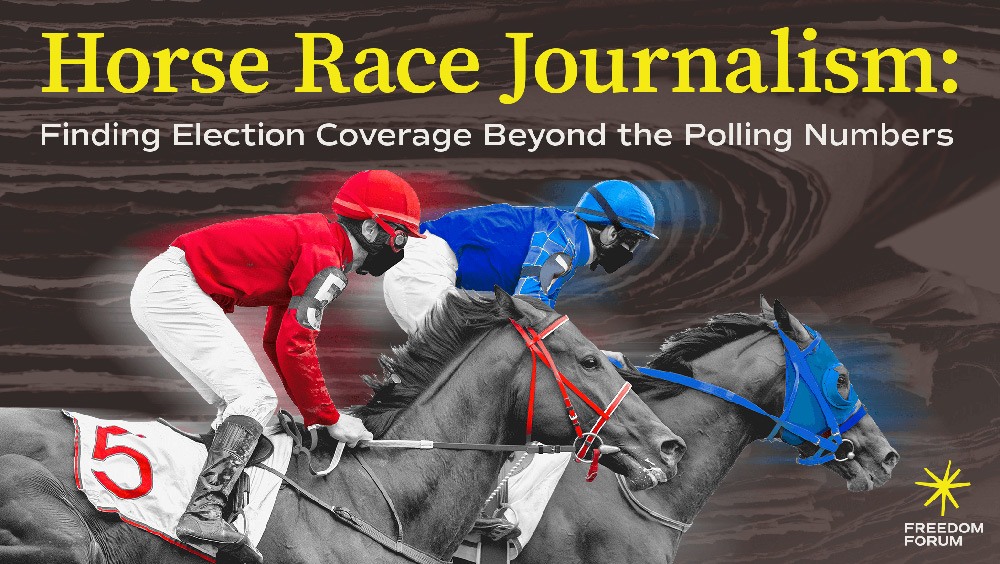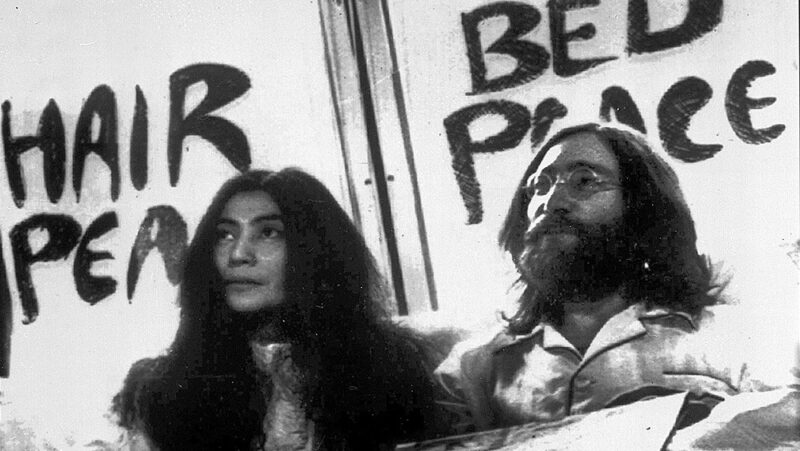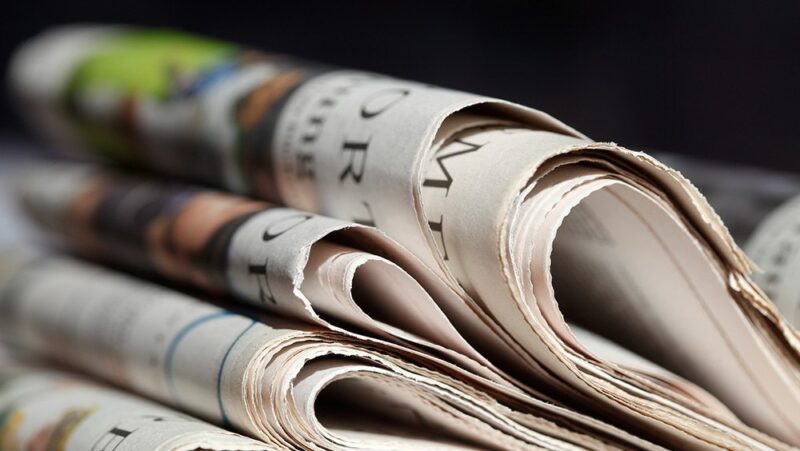Horse Race Journalism: Finding Election Coverage Beyond the Polling Numbers

And … they’re off!
Those three words closely associated with horse racing could easily apply to political races in the United States.
Horse racing and elections both have intense coverage when the field is close early in the race, the stakes are high, and there’s lots of money involved.
U.S. elections, particularly for president, attract news coverage that lasts much longer than the Kentucky Derby. The 2024 presidential election effectively began two years earlier in November 2022, when Donald Trump announced he would seek the Republican nomination for a third time. When Hillary Clinton first ran for president, she announced her bid in January 2007, a full year before the first nominating contests and nearly two years before the general election.
In this post, we take a deep dive into horse race journalism. We explain what it is, provide examples, give resources to lean into — or avoid — horse race journalism, and more.
What is horse race journalism?
Whether you want national, state or local election coverage, it’s not hard to find news based on polling. Many news outlets conduct their own polls or contract with outside firms to gauge potential interest in candidates and issues, sometimes years before an election.
Coverage like this that relies on surveying potential voters gets the nickname horse race journalism.
Political polls have evolved in recent decades to account for the changing ways people communicate – with fewer phone landlines and people wary of answering calls on their cell phones from unrecognized numbers.
This newer reality has led to criticism about political polling and horse race journalism being unreliable or unhelpful. Critics of poll-based coverage often point to the 2016 election, when most polls showed Clinton would beat Trump. But Trump won the election. 2020 election results also caused polling firms to evaluate their methods since many national polls overestimated support for Democrats.
Horse race journalism doesn’t only mean conducting and reporting on polls. More broadly, it’s a focus on the day-to-day ins-and-outs of campaigning: Who said what at a rally? Who posed for a photo with what group? Who posted what on social media and how did their opponent respond? Who “won” the debate or had the most “cringe” response to a question?
The race versus the stakes
Another way of covering elections focuses less on the race itself and more on the stakes. In other words: the outcomes of a candidate being elected and the policies they advocate for or against.
While criticisms of pre-election polls and journalists’ use of them have been around for decades, there has been a lot of recent discussion inside journalism circles about this race-versus-stakes dynamic.
How far back does the critique of horse race journalism go? Here's the Kearney (Nebraska) Hub editorializing on it Oct. 29, 1994. THIRTY years ago.
— Jay Rosen (@jayrosen_nyu) February 14, 2024
"The media has failed because we have reported on this year's election as if it were a horse race."
Hat tip, @flux_the_system pic.twitter.com/vXaiXS3QH2
Jay Rosen, New York University journalism professor and longtime press critic, is among the most prominent people who say news outlets need to do less horse race journalism and more coverage of the potential outcome.
“Not the odds, but the stakes,” Rosen wrote on X in March 2023. “That's my shorthand for the organizing principle we most need from journalists covering the 2024 election. Not who has what chances of winning, but the consequences for our democracy.”
Media scholars who study elections and news coverage and their effects on people might agree.
Writing for the Journalist’s Resource, a project of Harvard University’s Shorenstein Center on Media, Politics and Public Policy, Denise-Marie Ordway highlighted multiple studies on the topic.
“When journalists covering elections focus primarily on who’s winning or losing instead of policy issues – what’s known as horse race coverage – voters, candidates and the news industry itself suffer, a growing body of research suggests,” Ordway wrote.
Reporting on the race and the stakes can happen side-by-side or they can inform each other.
For example: A March 2024 poll from The Washington Post and University of Maryland reported voter preferences for the U.S. Senate race in the state. It showed popular former governor Larry Hogan, a Republican, with a sizable lead against either of two Democrats running against him. But the voters who said they preferred Hogan also said they wanted Democrats to retain control of the Senate. This was a notable finding given how control of the Senate may come down to Maryland and a few close states. Put another way: This poll sheds light on how the outcomes (the stakes) are high depending on what party people want to control the Senate versus who they prefer voting for in their own state.
During the 2024 primary season, a Fox News poll reported preferences of voters in Michigan, a key general election state. If Nikki Haley were the eventual Republican nominee, the state leaned toward Joe Biden. But if Trump were the nominee, Michigan voters preferred him. Both scenarios showed the impact of third-party candidates, especially Robert F. Kennedy Jr., on the eventual outcome. This kind of polling can shed light on the potential stakes: If primary voters choose these options, the general election (and the eventual outcome) could be affected in a certain way.
Options for polls or stakes information
Whether you’re a political junkie who hangs on every poll or someone who prefers dissecting policy and its effects on people, you have many options in election coverage. Here are a few sources to consider for both polls and deeper policy and voting information:
Polls and horse race reporting:
- Five Thirty Eight / ABC News
- Quinnipiac University polling
- New York Times polling
- Pew Research Center – Politics & Policy
- Marist Polls – with PBS NewsHour and NPR
- Siena College Research Institute polls
Policy/stakes reporting and informed voting information:
- Bolts Magazine
- NPR election issues tracker
- News From The States
- Pluribus News
- Find Your News – from the Institute for Nonprofit News
- Ballotpedia — nonprofit and nonpartisan encyclopedia source
- Vote Smart
- League of Women Voters
- News Literacy Project
- University of Washington, Center for an Informed Public
Campaign coverage, horse race journalism and the First Amendment
As a news consumer, there are plenty of options for information, especially at the national level. When you read and talk about the news coverage you like or don’t like, you’re enjoying your own freedoms of speech and the press.
While there are critics of horse race journalism, its use by news outlets is not only longstanding but protected by the First Amendment. The freedoms of speech and the press mean news outlets have broad leeway to report on the topics they want and do so with as many polls as they’d like.
You can even use your First Amendment freedoms to make your voice heard. If you don’t like the coverage you see, consider writing a letter to the editor or other commentary to a news outlet of your choosing. Once you have the information you need to make an informed decision, you can take one action to make your voice heard in our representative democracy: vote.
Scott A. Leadingham is a Freedom Forum staff writer. Email
5 Protests That Highlight the Power of Love
Marion County Record Newspaper Raid Should Concern Us All
Related Content
$30,000 Giving Challenge
Support the Freedom Forum’s First Amendment mission by Dec 31st and double your impact.

